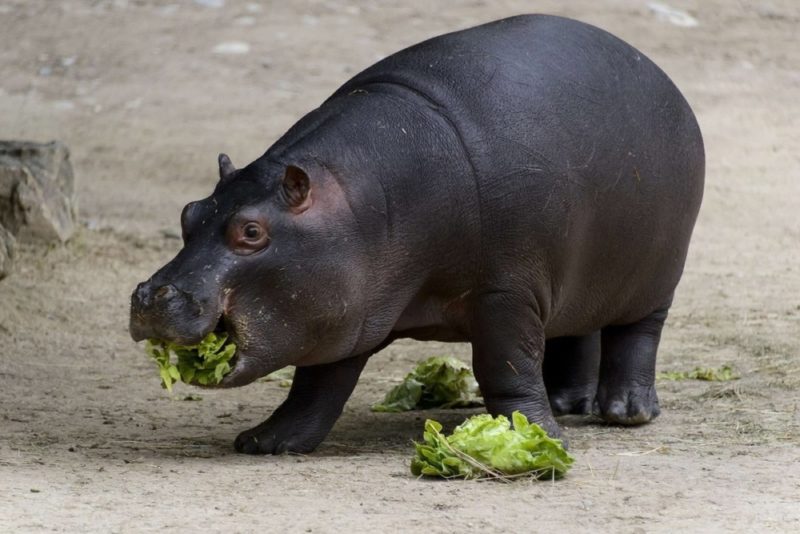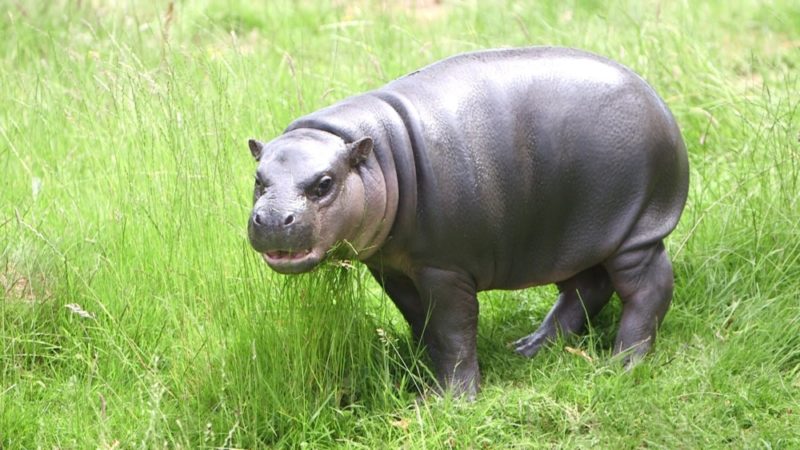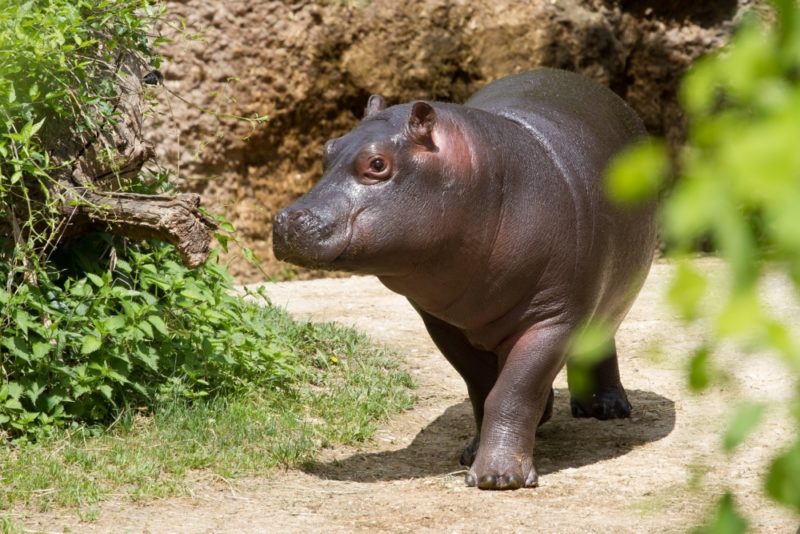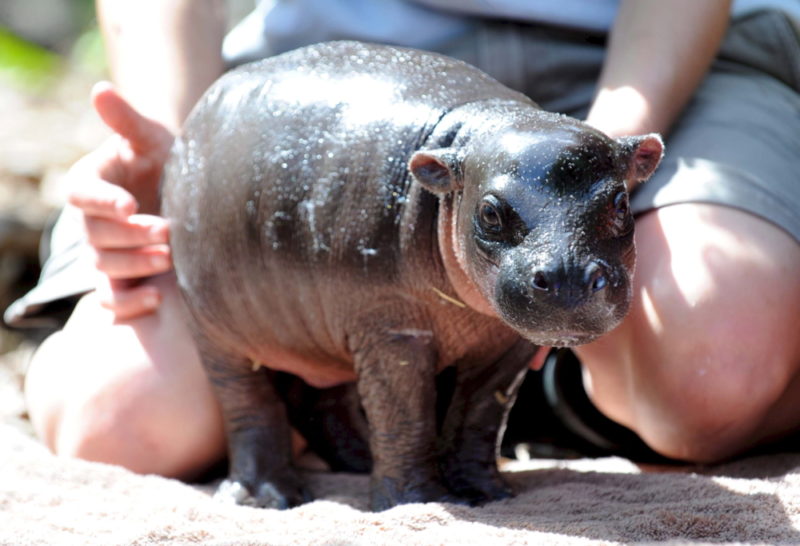The dwarf hippopotamus (nigbwe) is not at all the result of hybrid crosses of animals artificially bred by scientists, but the tricks of mother nature. For the first time they learned about a mammal back in 1843. And so far, this small mammal pleases and surprises visitors to zoos and reserves.
Material Content:
Description of the type of pygmy hippopotamus
The history of the origin of the dwarf hippo is not known for certain. The first mention of him appeared after the notes of anthropologist George Morton. In 1843, he went to Liberia to study the local population and wildlife.
What was his surprise when before leaving he was presented with two small hippos, which locals affectionately called "mwe-mwe." Animals had significantly smaller dimensions than their close relatives. It was Morton who first gave the name to a new species of mammal: the dwarf hippo.
But in Europe, mve-mwe was introduced only at the end of 1911. Did it scientist Hans Schomburg.
Outwardly, the dwarf hippo resembles its ordinary congener. But there are still differences.
They are as follows:
- Mini hippo is not so heavy. Its weight ranges from 270–280 kg. In this case, body weight can reach up to 4500 kg.
- The neck and legs are quite long, the head is elongated.
- Particular attention is paid to the spine of the animal. His back is visibly leaning forward.
- The eyes and nostrils are large, protruding slightly above the skull.
- The membranes on the paws are poorly developed. That is why dwarf hippos are not very good swimmers.
- In the mouth of an adult, experts count only one pair of incisors.
- The skin color is brown or greenish black.But in the abdomen, it is lighter.
- The sweat of the animal is painted in a light pink color.
- Growth mwe-mwe no more than 75 cm.
Presented mammals are centenarians. In the wild, they can live up to 35 years, in zoos a little more.
Artiodactyl habitat
A dwarf hippo lives where there is water. This is one of the main conditions for their existence. Mwe-mwe are rather timid, therefore they choose swamps, rivers with thickets and a slow course as a shelter.
Animals do not tolerate heat, so they avoid open areas without dense vegetation. Hippos love to spend time in burrows that are located on the river side. Semi-underwater lifestyle for them the most optimal.
An interesting fact is that the Nigbwe does not dig a future home. Other animals do it for him. Hippopotamus only increases its size.
Most of the mwe-mwe population is present in Liberia. Today, there are about 1000 individuals.
And they are also found in Guinea, Sierra Leone and Côte d’Ivoire. A small number of them live there. All of them, as a rule, live in reserves and in national parks.
Lifestyle, Nutrition and Behavior
Nigbwe is from the hippo family, so the animal devotes most of the time to splashing in water. If their skin dries up, serious health problems begin. Wounds appear on the dermis, which eventually fester.
On hot days, the pygmy hippopotamus does not come out of the water at all. He is in his shelter for days. He likes to swim, dive. Experts have proven that the animal can spend under water for up to 3 minutes, while holding its breath.
Dwarf hippos love solitude. In pairs, they can be found only during the mating season. The rest of the time they feel the presence of a friend from afar. This is indicated to them by the smells of feces, which they secrete during bowel movements. When meeting, individuals ignore each other. Fights between animals are very rare.
The period of activity falls at night. They get food on land and in water. Mwe-mwe is an herbivore animal. Among the favorite goodies are plants, fruits, herbs and even algae.
It is worth noting that the animal always marks the territory where it finds food. If other individuals wandered into the possessions, mwe-mwe is simply looking for a new place for housing. The pygmy hippopotamus is rather cowardly; occasionally it can be seen in the fields where crops grow. But when meeting people, he immediately runs away into the thicket of the forest.
Among the enemies of the herbivore, crocodiles and leopards can be distinguished. Some attack in the water, others on land. The fight is unequal. If a hippo is captured by a predator, it almost always dies.
For kids, pythons are especially dangerous. Reptiles are capable of swallowing the whole mwe-mwe cub.
How much does Madagascar dwarf hippo weigh
Madagascar pygmy hippopotamus belongs to an extinct genus of animals. Individuals lived on in those places about 1000 years ago.
According to the descriptions of specialists, such individuals weighed about 300 kg in ancient times. In length were no more than 2 meters. There were practically no enemies in this animal in the wild. But for humans, the mammal was easy prey. The extermination of the Madagascar species of hippos is associated with this.
Breeding and offspring of a ruminant
Almost nothing is known about the reproduction of dwarf hippos in the wild. But they actively mate and give birth in captivity.
Coitus can occur both on land and in water. Female estrus lasts several days, during which time intimate contacts are possible 3-4 times.
The time of year for childbearing does not matter. The future mother carries a fetus from 184 to 210 days. In most cases, one cub is born. There can rarely be twins.
Cubs are born large (3.5–7 kg). Males always weigh more. Kids are immediately well developed.
Direct delivery occurs on land.However, in the wild, this process in some cases can occur under water. For the most part, the ending of such situations turns out to be sad - a newborn nigbwe chokes in a pond.
Hippopotamus feeds offspring up to 7-8 months with breast milk. After that, she teaches calves to natural food. A juicy sedge is considered a treat.
Sexual maturity in individuals is achieved by 3-4 years.
Interesting Facts
Interesting facts about the pygmy hippo:
- Mwe-mwe refers to the endangered species of animals. They breed well in captivity, but in the wild, most babies die. Those lucky enough to grow up become victims of the local population of West Africa, who are actively destroying the population of this amazing species. That is why many zoos create all the conditions to host dwarf hippos. It is worth noting that the life expectancy of animals in captivity is longer than in the wild. And with proper care, some of them reach 43 years.
- Mwe-mwe is able to be under water for a long time. This was made possible thanks to the special structure of the ears and nose, the openings of which close tightly when immersed.
- Many, having seen the Nigbwe on a hot day, might think that his skin is bloodied. This is not true. Sweating, the animal secretes a pinkish-red liquid that protects it from sunlight and helps cool the skin.
- Nigbwe cannot exist for a long time without water in the sun. He rapidly loses moisture, which can die.
The dwarf hippopotamus is an endangered species, and therefore people need to show maximum care and attention in order to extend its presence in the wild. Special mammalian conservation programs are developed annually. In zoos, reserves, all conditions are created for a normal life and reproduction of mwe-mwe.
















